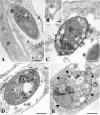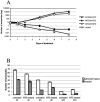In vitro efficacies of nitazoxanide and other thiazolides against Neospora caninum tachyzoites reveal antiparasitic activity independent of the nitro group
- PMID: 16127045
- PMCID: PMC1195425
- DOI: 10.1128/AAC.49.9.3715-3723.2005
In vitro efficacies of nitazoxanide and other thiazolides against Neospora caninum tachyzoites reveal antiparasitic activity independent of the nitro group
Abstract
The thiazolide nitazoxanide [2-acetolyloxy-N-(5-nitro-2-thiazolyl)benzamide] (NTZ) exhibits a broad spectrum of activities against a wide variety of intestinal and tissue-dwelling helminths, protozoa, and enteric bacteria infecting animals and humans. The drug has been postulated to act via reduction of its nitro group by nitroreductases, including pyruvate ferredoxin oxidoreductase. In this study, we investigated the efficacies of nitazoxanide and a number of other thiazolides against Neospora caninum tachyzoites in vitro. We employed real-time-PCR-based monitoring of tachyzoite adhesion, invasion, and intracellular proliferation, as well as electron microscopic visualization of the effects imposed by nitazoxanide. In addition, we investigated several modified versions of this drug. These modifications included on one hand the replacement of the nitro group on the thiazole ring with a bromide, thus removing the most reactive group, and on the other hand the differential positioning of methyl groups on the salicylate ring. We show that the thiazole-associated nitro group is not necessarily required for the action of the drug and that methylation of the salicylate ring can result in complete abrogation of the antiparasitic activity, depending on the positioning of the methyl group. These findings indicate that other mechanisms besides the proposed mode of action involving the pyruvate ferredoxin oxidoreductase enzyme could be responsible for the wide spectrum of antiparasitic activity of NTZ and that modifications in the benzene ring could be important in these alternative mechanisms.
Figures








References
-
- Ammann, P., A. Waldvogel, I. Breyer, M. Esposito, N. Müller, and B. Gottstein. 2004. The role of B- and T-cell immunity in toltrazuril-treated C57BL/6 WT and μMT and nude mice experimentally infected with Neospora caninum. Parasitol. Res. 93:178-187. - PubMed
-
- Broekhuysen, J., A. Stockis, R. L. Lins, J. De Graeve, and J. F. Rossignol. 2000. Nitazoxanide: pharmacokinetics and metabolism in man. Int. J. Clin. Pharmacol. Ther. 38:387-394. - PubMed
-
- Cannas, A., A. Naguleswaran, N. Müller, B. Gottstein, S. Eperon, and A. Hemphill. 2003. Vaccination of mice against experimental N. caninum infection using NcSAG1- and NcSRS2-based recombinant antigens and DNA-vaccines. Parasitology 126:303-312. - PubMed
-
- Cannas, A., A. Naguleswaran, N. Müller, B. Gottstein, and A. Hemphill. 2003. Protective effect of vaccination with recombinant microneme protein NcMIC3 in mice following challenge infection with Neospora caninum tachyzoites. J. Parasitol. 89:44-50. - PubMed
-
- Darius, A. K., H. Mehlhorn, and A. O. Heydorn. 2004. Effects of toltrazuril and ponazuril on the fine structure and multiplication of tachyzoites of the NC-1 strain of Neospora caninum (a synonym of Hammondia heydorni) in cell cultures. Parasitol. Res. 92:453-458. - PubMed
Publication types
MeSH terms
Substances
LinkOut - more resources
Full Text Sources
Other Literature Sources

